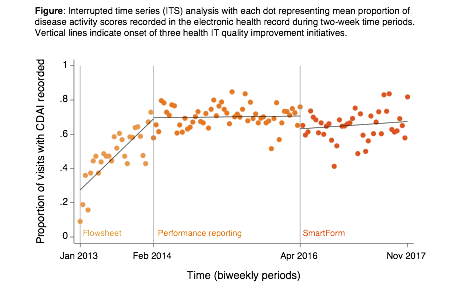Session Information
Session Type: ACR Poster Session A
Session Time: 9:00AM-11:00AM
Background/Purpose: Regular assessment of disease activity is a fundamental part of high quality RA care. Customization of electronic health records (EHRs) can facilitate the systematic collection of disease activity scores as part of a treat-to-target approach to RA treatment. We aimed to evaluate the overall impact of 3 health IT initiatives at the point of care on documentation of RA disease activity scores in an academic rheumatology clinic.
Methods: We studied 3 initiatives designed to facilitate documentation of a validated RA measure, the Clinical Disease Activity Index (CDAI), over a 5-year period (see Figure): 1) an Epic¨ flowsheet to input and track scores using structured fields, 2) peer reporting of provider performance on their individual proportion of RA visits with documented CDAI, and 3) an Epic¨ SmartForm that included a CDAI calculator alongside workflow changes to optimize CDAI documentation. The study included all adult RA patients with ³ 2 visits in a rheumatology clinic at a tertiary care center between June 2012-October 2017. Clinical data were retrieved from the EHR data warehouse. Interrupted time-series (ITS) analysis was used to assess whether the proportion of visits with a CDAI documented in the EHR changed following implementation of each initiative. Provider surveys assessing satisfaction with CDAI documentation workflows (1-10 scale) and time spent documenting disease activity were administered immediately before and 24 months after the third initiative.
Results: We included data from 995 unique patients with 8,040 encounters. Mean (SD) age was 58.9 (16) years, 82% were female, and 66% were non-Hispanic White. Over 60 months, overall documentation of CDAI scores increased from 0% to 64%. After introduction of the flowsheet, ITS analysis showed an immediate increase in documentation (28.1%, p<0.05) (Figure), followed by a steady rise (1.4% increase per 2-week period, p<0.05). Documentation remained stable after peer performance reporting. The SmartForm was associated with a small immediate decrease (-7.8%, p<0.05), followed by a rise back to near pre-intervention levels. Provider satisfaction with documentation increased (from 5.4±2.5 to 7.5±1.4) after SmartForm implementation and average time for RA disease activity documentation decreased (from 6.5±5.3 to 3.2±1.9 minutes).
Conclusion: Introducing an EHR flowsheet improved documentation of CDAI, and additional culture and workflow changes maintained these gains. This study illustrates how EHR optimizations evolve in stages, with an initial focus on health IT and subsequent attentions to workflows and provider satisfaction. Overall, modifications to the EHR, culture, and workflows proved to be an effective method of driving increased documentation of disease activity without compromising provider satisfaction.
To cite this abstract in AMA style:
Gandrup J, Li J, Izadi Z, Gianfrancesco M, Ellingsen T, Yazdany J, Schmajuk G. Three Health It Interventions Increased Documentation of RA Disease Activity Scores in an Academic Rheumatology Clinic: Results from an Interrupted Time Series Study [abstract]. Arthritis Rheumatol. 2018; 70 (suppl 9). https://acrabstracts.org/abstract/three-health-it-interventions-increased-documentation-of-ra-disease-activity-scores-in-an-academic-rheumatology-clinic-results-from-an-interrupted-time-series-study/. Accessed .« Back to 2018 ACR/ARHP Annual Meeting
ACR Meeting Abstracts - https://acrabstracts.org/abstract/three-health-it-interventions-increased-documentation-of-ra-disease-activity-scores-in-an-academic-rheumatology-clinic-results-from-an-interrupted-time-series-study/

